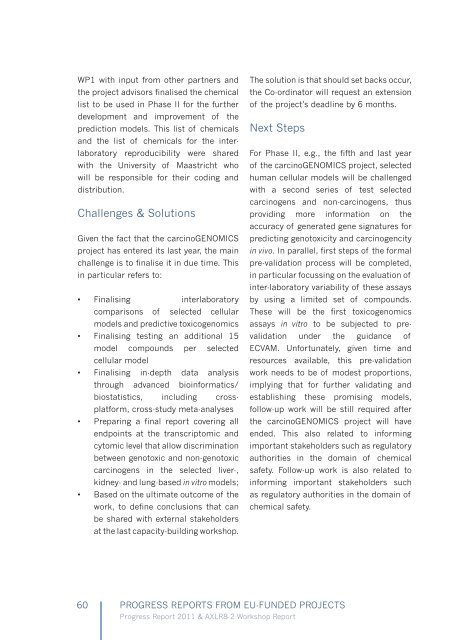Create successful ePaper yourself
Turn your PDF publications into a flip-book with our unique Google optimized e-Paper software.
WP1 with input from other partners and<br />
the project advisors finalised the chemical<br />
list to be used in Phase II for the further<br />
development and improvement of the<br />
prediction models. This list of chemicals<br />
and the list of chemicals for the interlaboratory<br />
reproducibility were shared<br />
with the University of Maastricht who<br />
will be responsible for their coding and<br />
distribution.<br />
Challenges & Solutions<br />
Given the fact that the carcinoGENOMICS<br />
project has entered its last year, the main<br />
challenge is to finalise it in due time. This<br />
in particular refers to:<br />
• Finalising interlaboratory<br />
comparisons of selected cellular<br />
models and predictive toxicogenomics<br />
• Finalising testing an additional 15<br />
model compounds per selected<br />
cellular model<br />
• Finalising in-depth data analysis<br />
through advanced bioinformatics/<br />
biostatistics, including crossplatform,<br />
cross-study meta-analyses<br />
• Preparing a final report covering all<br />
endpoints at the transcriptomic and<br />
cytomic level that allow discrimination<br />
between genotoxic and non-genotoxic<br />
carcinogens in the selected liver-,<br />
kidney- and lung-based in vitro models;<br />
• Based on the ultimate outcome of the<br />
work, to define conclusions that can<br />
be shared with external stakeholders<br />
at the last capacity-building workshop.<br />
The solution is that should set backs occur,<br />
the Co-ordinator will request an extension<br />
of the project’s deadline by 6 months.<br />
Next Steps<br />
For Phase II, e.g., the fifth and last year<br />
of the carcinoGENOMICS project, selected<br />
human cellular models will be challenged<br />
with a second series of test selected<br />
carcinogens and non-carcinogens, thus<br />
providing more information on the<br />
accuracy of generated gene signatures for<br />
predicting genotoxicity and carcinogencity<br />
in vivo. In parallel, first steps of the formal<br />
pre-validation process will be completed,<br />
in particular focussing on the evaluation of<br />
inter-laboratory variability of these assays<br />
by using a limited set of compounds.<br />
These will be the first toxicogenomics<br />
assays in vitro to be subjected to prevalidation<br />
under the guidance of<br />
ECVAM. Unfortunately, given time and<br />
resources available, this pre-validation<br />
work needs to be of modest proportions,<br />
implying that for further validating and<br />
establishing these promising models,<br />
follow-up work will be still required after<br />
the carcinoGENOMICS project will have<br />
ended. This also related to informing<br />
important stakeholders such as regulatory<br />
authorities in the domain of chemical<br />
safety. Follow-up work is also related to<br />
informing important stakeholders such<br />
as regulatory authorities in the domain of<br />
chemical safety.<br />
60 PROGRESS REPORTS FROM EU-FUNDED PROJECTS<br />
Progress Report 2011 & AXLR8-2 Workshop Report




